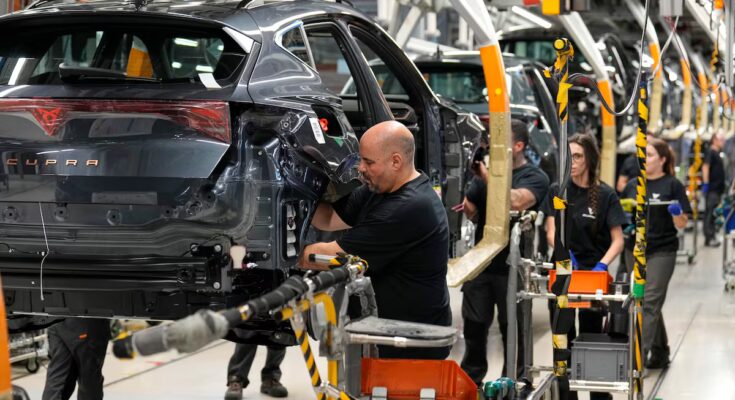Automotive production in Spain will close 2025 with a decline compared to last year. According to data published this Wednesday by the national association of the automotive industry, Anfac, in the month of October 211,072 vehicles left Spanish factories, which represents a drop of 7.4% compared to the same month of 2024. In the cumulative figure for the year, the drop is 5.4%, with just over 1.9 million cars assembled, mainly due to weak European demand, where the main markets have reduced registrations or remained unchanged. stagnant.
“After a September in which there was a growth in production, we return to this year’s trend, characterized by a downward trend in both production and export numbers”, complained the general director of Anfac, José López-Tafall. This association also highlights the impact that the adaptation that some factories are making for the arrival of new models is having on production data, such as Mercedes-Benz in Vitoria, which next year will make its new electric vans based on the VAN.EA platform.
Although Anfac does not break down the data by plant, the delicate situation of Ford Almussafes affects the global calculation. The American company’s plant stopped producing its Transit Connect van in April last year and remained exclusively with the Ford Kuga, which led it to approve a new ERE (Employment Regulatory File), the fourth since 2020, in addition to making use of the RED mechanism, with which it imposed a sort of rotating ERTE (Temporary Employment Regulatory File) on the workforce. In recent years this factory, which was one of the largest in the country, has gone from producing five examples to producing just one model. Ford has promised the arrival of a new car in 2027 that will reactivate the factory’s activity with up to 300,000 units per year.
On the other hand, López-Tafall took the opportunity to recall the opportunity that the revision of the decarbonisation objectives that the European Union has accepted represents for the sector, due to pressure from some countries and the lobby which represents the sector in the Old Continent, ACEA. “Both Europe and Spain must reverse this very negative trend in one of the driving sectors of the economy and innovation. The review of regulations affecting the sector in Europe must serve to recover industrial competitiveness as a desirable objective, and align it with that of decarbonisation”, said the manager, who added that Spain “cannot stand still”. For this reason, he underlined the importance of the Auto Plan 2030, which the sector and the president of the government, Pedro Sánchez, will present before the end of the year, which includes various measures for the automobile, as well as a new aid plan for the purchase of electric cars.
Spain produces fewer electric cars than in 2024
As regards energy sources, national production continues to focus on petrol cars, with a share of 40.3% (although it drops by 8.9 points compared to the first ten months of 2024) and on non-plug-in hybrids, which represent 26.7% of Spanish production. Electric vehicles fell by 14.7% and lost a production share of 0.5 points, to 88,281 units, but plug-in hybrids made up for this decline with an increase of 32.8%, to 101,134 cars. Overall, electrified vehicles represent 9.9% of what is produced in the country, with over 189,000 units and an increase of 5.4% compared to the same period last year.
As regards car exports, these decreased by 10.9% in October, with 178,582 units, while in the cumulative year the decline was 8.9%, with almost 1.64 million vehicles. Europe, even though it brings together almost all car exports produced in Spainwith 91.8%, it reduced its market share by 2.3 points compared to October 2024. Germany, France and Türkiye remain the three main buyers of Spanish cars.



